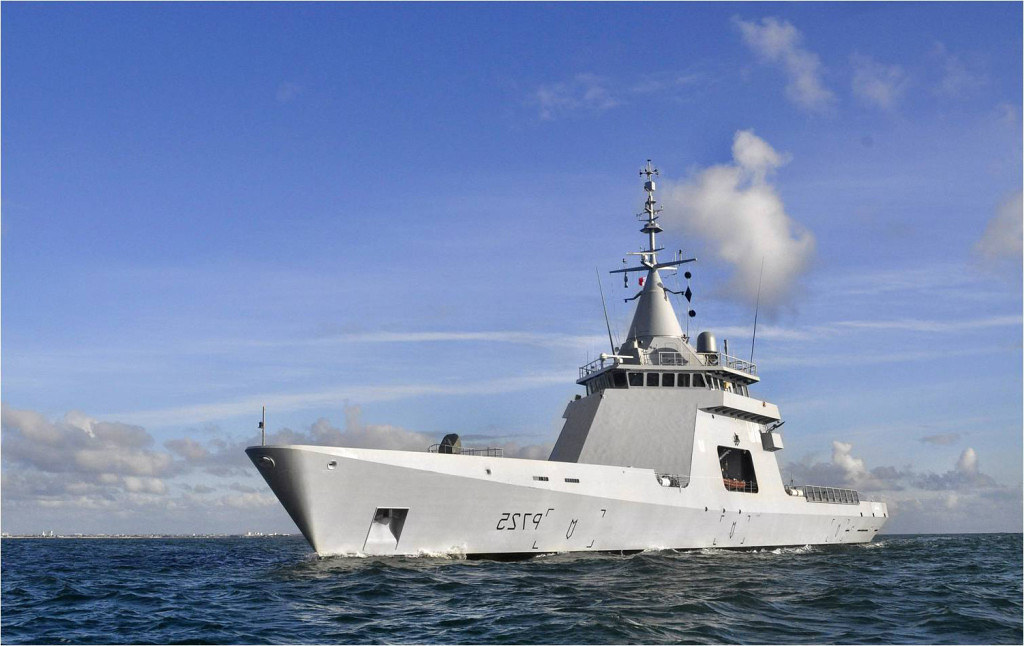
Construction of the first vessel in the class commenced in May 2024, and recent images shared by local ship spotter C. des Déserts reveal that the hull is now fully assembled, marking a major milestone in the project. Naval News spoke with the DGA program director for an update on the progress of the “PH” program.
What is the current status of the program?
DGA: The program has been underway since November 2023. The first three ships are being built simultaneously at the selected shipyards—Piriou, CMN, and Socarenam—working together as a temporary consortium for phases 1 through 3. Naval Group serves as both the design authority and the main contractor for the combat and management systems of the platform.
When will Piriou launch the first-in-class OPV?
DGA: The launch of PH1 “Trolley de Prévaux” is planned for the first quarter of 2026.
Have construction activities started at CMN and the Concarneau shipyards? When will they launch their ships?
DGA: Construction of PH2 “d’Estiennes d’Orves” began in February 2025, while PH3 “Jeanne Bohec” started in June 2025. They are scheduled for launch in early and late 2027, respectively.
The Patrouilleurs Hauturiers Program
On November 17, 2023, the DGA placed an order for the first seven vessels to modernize the French Navy’s maritime surveillance and intervention fleet. These multi-role combat patrol vessels, designed by Naval Group, are being built by PIRIOU, CMN, and SOCARENAM under the supervision of the DGA. Naval Group is responsible for overseeing the construction process on behalf of the DGA.
The initial design phase started in October 2020, and the detailed design was finalized by October 2023. Construction of the first vessel began on May 22, 2024, at PIRIOU’s Concarneau shipyard, with delivery expected in April 2027 (slightly delayed from the original late-2026 schedule). The final ship from this batch of seven will be delivered in 2030, with an additional three vessels anticipated in future orders, in line with the 2024–2030 military planning framework.
All ships are set to be operational by 2035 and will carry the names of notable men and women who served with distinction during World War II, with the exception of one vessel named “Île de Sein,” honoring the Breton commune whose men joined the Free French forces and which was awarded the prestigious Order of the Liberation.
Technical Specifications of the New PH Offshore Patrol Vessel
The new OPVs will have a displacement of approximately 2,400 tonnes and a length of 92 meters, making them larger and more capable than their predecessors. They will be powered by a diesel-electric propulsion system, achieving speeds exceeding 21 knots, with an endurance of up to 6,000 nautical miles or 30 days at sea. The beam will measure 14.2 meters, the draft 3.6 meters, and each vessel will accommodate 84 personnel (crew and passengers). Designed for longevity, the vessels are expected to have a service life of 35 years, with an availability target of 140 days at sea annually (eventually aiming for 220) and overall operational readiness of 300 days per year.
For onboard systems, Naval Group has developed and delivered the SETIS-C combat management system (CMS) and the SHIPMASTER automated platform management system, which handles monitoring and control of electrical and auxiliary systems as well as safety and alert mechanisms. Exail provides navigation hardware such as the Phins Inertial Navigation System (INS) and Netans Data Distribution Units (DDU). Thales supplies the NS54 4D AESA multi-function X-band naval radar (also used in the new-generation MCMVs for the Netherlands and Belgium), the TSA 3522 IFF interrogator, and the BLUEWATCHER hull-mounted sonar (HMS).
These technologies will enable the OPVs to perform missions involving surface and aerial surveillance, underwater threat detection, fire control, and target identification. The inclusion of sonar, unusual for a patrol vessel, addresses growing underwater threats around French waters and will support SSBN protection by deploying ahead of submarines to provide intelligence and deterrence.
The ship’s configuration features an integrated mast above the bridge, housing the NS54 radar in its top dome. On either side are navigation and surveillance radars (likely from Wartsila and Terma), meteorological instruments, surveillance cameras, and communication antennas. Positioned forward is the Safran VIGY 4 panoramic stabilized day/night observation system, with SATCOM domes and additional antennas around the mast.
Weapons and Defensive Systems
The PH OPVs will be equipped with a Thales/KNDS RAPIDFire 40mm main gun and an MBDA SIMBAD RC short-range air-defense system. Three of the four antennas for the HYDRA counter-unmanned aerial system (C-UAS) by CERBAIR are integrated into the ship’s superstructure around the panoramic bridge (the fourth is positioned aft above the hangar). Additional armaments include 12.7mm heavy machine guns, life-saving gear, and a 7.62mm general-purpose machine gun mounted on the port side above the hangar.




